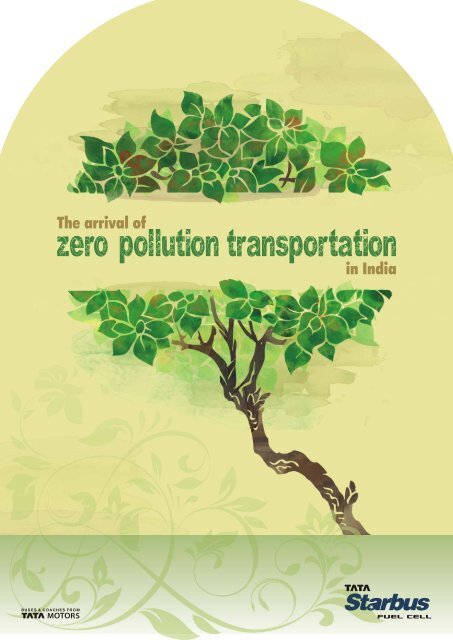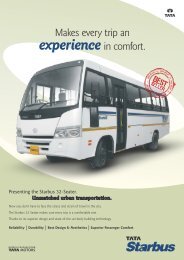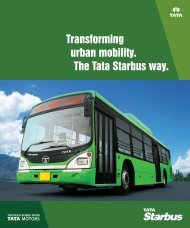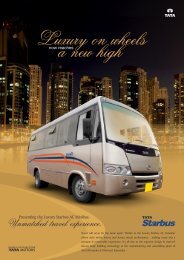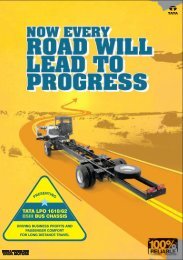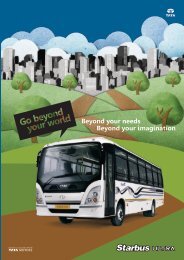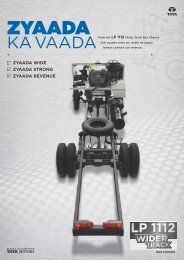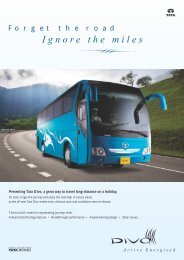Starbus Fuel Cell - Buses - Tata Motors
Starbus Fuel Cell - Buses - Tata Motors
Starbus Fuel Cell - Buses - Tata Motors
Create successful ePaper yourself
Turn your PDF publications into a flip-book with our unique Google optimized e-Paper software.
The arrival of<br />
in India<br />
FUEL CELL
Across the world, governments are introducing legislation<br />
that ensures the adoption of practices for a<br />
cleaner and greener world. A major focus is on finding<br />
cleaner alternate fuels for use in public transportation.<br />
The objective is to use fuels that are sustainable.
In India, <strong>Tata</strong> <strong>Motors</strong> has always led the drive for using<br />
cleaner fuels for public transportation. Way back in 1999,<br />
the company introduced CNG buses, followed by the<br />
revolutionary CNG Electric Hybrid buses in 2010. And now<br />
in 2012, it has taken the lead to introduce the latest fuel cell<br />
technology with the new <strong>Starbus</strong> <strong>Fuel</strong> <strong>Cell</strong> bus.<br />
<br />
<br />
<br />
The technology that powers the <strong>Starbus</strong> <strong>Fuel</strong> <strong>Cell</strong> is used in many countries, to run both passenger cars and<br />
public transportation. In London alone, over 100 fuel cell buses transport people. Another 50 such buses<br />
are running in North and South America, Europe, Asia and Australia. In India, once again <strong>Tata</strong> <strong>Motors</strong> has<br />
played a pioneering role by bringing this first-of-its-kind technology on Indian roads.<br />
The fuel stack is fitted on the rear module<br />
of the bus, as shown below:
About three times more efficient than combustion, a fuel cell operates like a battery but<br />
without any need for recharging. The fuel cell generates electricity and water as long<br />
as the fuel - hydrogen and oxygen, are supplied to it.<br />
The power to drive the bus motor involves an electrochemical process, not combustion<br />
Hydrogen and oxygen combine to generate electricity which is converted to<br />
mechanical energy, to drive the motor<br />
<strong>Fuel</strong> cell vehicles produce zero pollution since only water and heat are the by-products<br />
<br />
A fuel cell consists of two catalyst coated electrodes with an electrolyte<br />
• When hydrogen enters the anode, electrons & protons from the atoms get<br />
separated due to the catalyst<br />
• Protons pass through the electrolyte to the cathode<br />
• Electrons are directed through an external circuit, thereby generating electricity<br />
• At the cathode, oxygen combines with the protons & electrons to produce<br />
water and heat<br />
Individual fuel cells are placed in a row to form a fuel cell stack, to generate a high<br />
amount of electrical energy, to power a vehicle<br />
In <strong>Starbus</strong>, a Proton Exchange Membrane (PEM) type of fuel cell is used due to high<br />
power density, which can vary the output quickly for start-up, making it popular for<br />
use in automobiles<br />
Excess<br />
<strong>Fuel</strong><br />
PEM FUEL CELL<br />
Electrical Current<br />
e- e-<br />
e-<br />
e-<br />
H+<br />
H +<br />
H 2 H +<br />
H +<br />
Water and<br />
Heat Out<br />
H O 2<br />
O 2<br />
<strong>Fuel</strong> In<br />
Air In<br />
Anode Electrolyte Cathode
The use of fuel cell technology in the <strong>Starbus</strong> <strong>Fuel</strong> <strong>Cell</strong> bus ensures a host of benefits.<br />
They cover both efficiency & performance parameters as well as the environment.<br />
Enhances Efficiency & Performance<br />
• Gasoline engines in conventional buses are less than 20% efficient in converting<br />
chemical energy to power whereas <strong>Starbus</strong> <strong>Fuel</strong> <strong>Cell</strong> offers 40-60% efficiency, i.e. 3 times more<br />
• <strong>Starbus</strong> <strong>Fuel</strong> <strong>Cell</strong> ensures 50% reduction in fuel consumption<br />
• A dependable, mobile and flexible system<br />
• Domestically produced fuel – no dependency on foreign policies<br />
• Fast refuelling ensures reduced downtime<br />
Improves the Environment<br />
• Reduction of air pollution today - possibility of eliminating pollution in future<br />
• The only emission is water vapour<br />
• In the conventional sense, <strong>Starbus</strong> <strong>Fuel</strong> <strong>Cell</strong> is a ZERO POLLUTION bus<br />
• Totally safe, clean & quiet operation<br />
• <strong>Starbus</strong> <strong>Fuel</strong> <strong>Cell</strong> is COMPLETELY NOISELESS because it doesn't run on a combustion<br />
engine, thereby emerging as a major driver of environmental initiatives<br />
• Significantly enhanced ride experience for both driver and passengers because of:<br />
Quiet & effortless acceleration, for less fatigue<br />
<br />
Quiet & smooth ride, for a highly relaxing journey
FUEL CELL<br />
Bus<br />
LPO 1625 Hydrogen <strong>Fuel</strong> <strong>Cell</strong> Bus<br />
Seating Capacity 30<br />
<strong>Fuel</strong> <strong>Cell</strong> Power System<br />
<strong>Fuel</strong> <strong>Cell</strong> Gross Peak Power<br />
Air Compressor for <strong>Fuel</strong> <strong>Cell</strong><br />
<strong>Fuel</strong> System<br />
Total Useful Amount of <strong>Fuel</strong><br />
Electric Propulsion Motor<br />
Peak Power Output of Motor<br />
Rated Speed<br />
Rated Torque<br />
Enerygy Storage System<br />
Steering<br />
Suspension<br />
Brakes<br />
Tyres<br />
Electrical System<br />
Max. Speed<br />
Hydrogen <strong>Fuel</strong> <strong>Cell</strong><br />
114 HP<br />
Single Stage Twin Screw Type<br />
Roof-mounted Hydrogen Cylinders; 4 nos. (205 ltr capacity each)<br />
14.5 kg<br />
2 Rear - AC Induction <strong>Motors</strong> with Summation Gearbox<br />
250 HP<br />
Idle: 600 rpm; Max.: 2100 rpm<br />
1050 Nm at 800 rpm<br />
Li - Ion Battery<br />
Hydraulic Power Steering<br />
Pneumatic Suspension & Hydraulic Double Acting Telescopic-type Shock Absorber at Front & Rear<br />
Full Air Dual Circuit SCAM with ABS<br />
11 R 22.5 Radial Tubeless; 7 nos.<br />
System Voltage - 24 V DC; Battery - 2 x 12V, 150 Ah; Alternator - 75 Amps<br />
70 kmph<br />
Gradeability 17%<br />
Wheelbase<br />
Body Dimensions (LxWxH)<br />
Floor Height<br />
6300 mm<br />
12000 mm x 2600 mm x 3500 mm<br />
390 mm<br />
You can contact our Sales Office: <strong>Tata</strong> <strong>Motors</strong> Limited, 20th Floor, Tower 2, One Indiabulls Centre, 841 Senapati Bapat Marg,<br />
Mumbai 400 013.Tel: (022) 6658 6000; Fax: (022) 66586010. Email: businfo@tatamotors.com<br />
The illustrations and photographs may show accessories and items of optional equipment which are not part of standard specifications. Due to printing processes,<br />
colours may vary slightly from those shown. All listed specifications are current and subject to change or upgrades without prior notice, in accordance with the<br />
Company’s policy of continuous product improvement.


